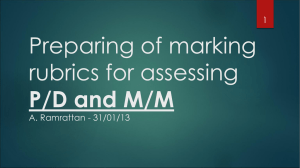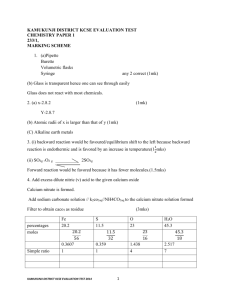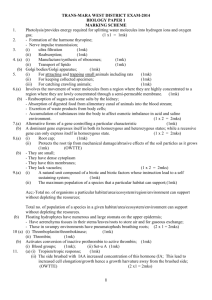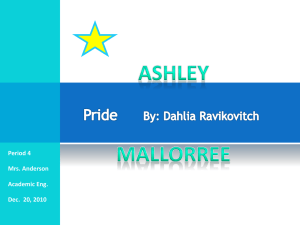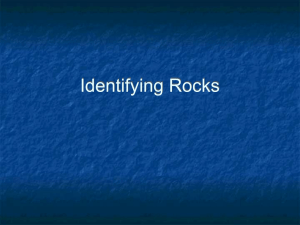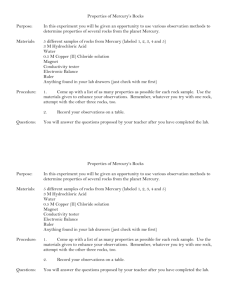kakamega geog p1 mscheme
advertisement
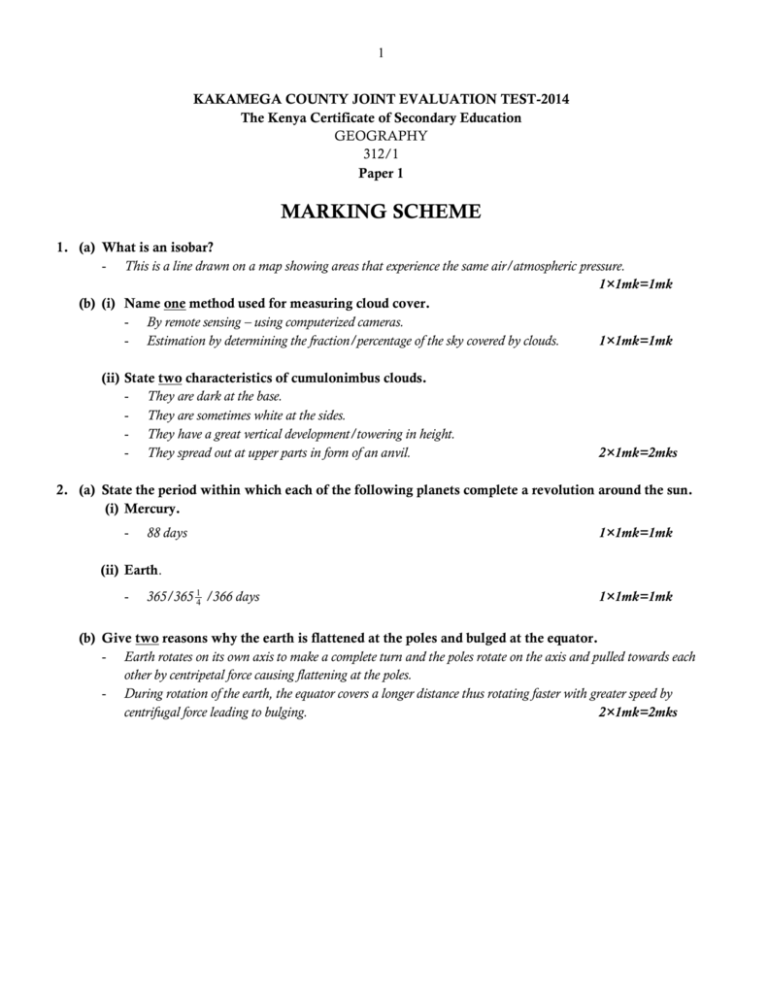
1 KAKAMEGA COUNTY JOINT EVALUATION TEST-2014 The Kenya Certificate of Secondary Education GEOGRAPHY 312/1 Paper 1 MARKING SCHEME 1. (a) What is an isobar? - This is a line drawn on a map showing areas that experience the same air/atmospheric pressure. 1×1mk=1mk (b) (i) Name one method used for measuring cloud cover. - By remote sensing – using computerized cameras. - Estimation by determining the fraction/percentage of the sky covered by clouds. 1×1mk=1mk (ii) State two characteristics of cumulonimbus clouds. - They are dark at the base. - They are sometimes white at the sides. - They have a great vertical development/towering in height. - They spread out at upper parts in form of an anvil. 2×1mk=2mks 2. (a) State the period within which each of the following planets complete a revolution around the sun. (i) Mercury. - 88 days 1×1mk=1mk (ii) Earth. - 365/365 14 /366 days 1×1mk=1mk (b) Give two reasons why the earth is flattened at the poles and bulged at the equator. - Earth rotates on its own axis to make a complete turn and the poles rotate on the axis and pulled towards each other by centripetal force causing flattening at the poles. - During rotation of the earth, the equator covers a longer distance thus rotating faster with greater speed by centrifugal force leading to bulging. 2×1mk=2mks 2 3. (a) State three causes of earthquakes. - Tectonic activities/movements/convergence & collision of plates/shifting of tectonic plates. - Isostatic adjustments i.e. relative movements between the continental and oceanic crusts during isostatic recovery may trigger off earthquakes as a state of balance is restored. - Vulcanicity/magma movement within the crust can cause tremors since the overlying crustal rocks are being displaced suddenly by the strong convectional currents/magma. - Gravitative pressure i.e. crustal rocks overlying the voids left behind by erupting magma are pushed inwards by force of gravity causing them to shake in the process hence earthquakes. - Human activities/construction of large reservoirs/explosives used in mines and road construction/movement of underground trains/explosions from underground nuclear tests – all these may send shock waves to the crustal rocks and cause earthquakes. 3×1mk=3mks N/B – at least 1 human cause and 1 natural cause should be stated to score all the marks. (b) Name two major earthquake zones of the world. - Mid Atlantic Belt/Mid Indian Ocean Ridge. - The Great Rift Valley Region. - The Circum – Pacific Belt/Ring of Fire. - The Mediterranean Belt/Mid – South East Asian Region. 2×1mk=2mks 4. The tables below represent temperature and rainfall for two stations X and Y. Study them and answer the questions that follow. Station X Months Jan Feb Mar Apr May Jun Jul Aug Sep Oct Nov Dec Temperature (0C) 27 27 27 26 25 25 25 26 27 27 26 26 Rainfall (mm) 65 85 150 250 225 125 75 75 75 112 125 125 Station Y Months Jan Feb Mar Apr May Jun Jul Aug Sep Oct Nov Dec Temperature (0C) 27 28 27 27 26 24 23 23 24 24 26 27 Rainfall (mm) 68 81 142 286 187 28 28 28 36 55 68 78 (a) (i) Calculate the annual range of temperature for the stations X and Y. - X ; 270 – 250 = 20C - Y ; 280C – 230C = 50C (ii) Calculate the annual rainfall for station Y. - 68+81+142+286+187+28+28+28+36+55+68+78 = 1085mm (b) Describe the characteristics of rainfall for station X. - The station experiences high rainfall/heavy. 1×1mk=1mk 1×1mk=1mk 1×1mk=1mk 3 - The rain falls throughout the year/it has no real dry season. The station experiences a double maxima rainfall regime/two peak rain seasons. 5. (a) Name two types of boundaries associated with plate tectonics theory. - Transform faults/conservative boundaries. - Extension boundaries/constructive margins/divergent. - Compressional boundaries/destructive margins /convergent. 3×1mk=3mks 2×1mk=2mks (b) State four evidences that support the continental drift theory. - Jig saw fit of continental margins e.g, eastern coastline of South America and western coastline of Africa. - Similar geological structures between rocks in Brazil (South America) and Republic of South Africa (Africa). - Distribution of ancient glacial deposits. - Sea floor spreading i.e. younger rocks in the middle of oceans while older rocks found near the coasts - Palaeontological evidence i.e. similarities of fossils in southern continents and between North America and Europe. - Palaeomagnetic evidence shows similarities in magnetic alignment in minerals in igneous. - Palaeozoic glacial deposits found widely dispersed in continents of India, Australia and South America. - Climatological evidence points to coal today found in temperate latitudes but are believed to have formed in tropical climates. 4×1mk=4mks 6. Study the map of KITALE (Sheet 75/3, Scale 1:50 000) provided and answer the questions that follow. (a) (i) Give the six figure grid reference for the Air Photo Principle point marked 95 found in the north – western part of the area covered by the map. - 228322 1×2mks=2mks (ii) Name two human made features found at grid square 4514. - Settlements/houses/housing units/Huts. - Plantation - Air Photo Principle Point - Other tracks/footpaths. (b) (i) 2×1mk=2mks Name two other districts covered by the map apart from Trans Nzoia District. - Elgeyo Marakwet - West Pokot 2×1mk=2mks (ii) What was the magnetic declination at the time when the map was drawn? - 20231 (c) (i) 1×2mk=2mks Calculate the area covered by Kapolet Forest reserve. Give your answer in square kilometres. - Complete squares = 1 4 - Incomplete squares = 29÷ 12 =14.5 - Total squares = 14.5+1=15.5 Area = 15.5×1km2 = 15.5km2 ±0.5km2 ; 15 – 16 km2 1×2mks=2mks (ii) Measure the distance of the all-weather road loose surface C 641 from the junction at grid square 2413 up to the junction at grid square 3121. Give your answer in kilometres. - 10km 400m ± 100m i.e. 10km 300m to 10km 500m 1×2mks=2mks (iii) Calculate the gradient of the same road in (c) (ii) above - VR 100 HE 10400 1 1 in 104 or 1:104 or 104 Gradient = 1×2mks=2mks 5 (d) (i) Using a vertical scale of 1cm to represent 50 metres, draw a cross-section from grid reference 290140 to 355180. (4 marks) A CROSS-SECTION FROM 290140 TO 355180 ON KITALE MAP – 75/3 Title – 1mk Vertical Scale & Axis labeled – 1mk Start & End Points labeled – 1mk Trend – 1mk Dry Weather Road C 637 – 1mk Wattle Plantation – 1 mk River Koitobos – 1mk (ii) On the cross-section, mark and name: Dry Weather Road C 637 Wattle Plantation River Koitobos (e) Describe the drainage of the area covered by the map. The mapped area is mainly drained by many rivers e.g. Koitobos, Saiwa, Kapolet, and Noigameget. The rivers are mainly permanent. The rivers generally flow from the northern to the southern parts of the mapped area. The mapped area is also drained by lakes/dams e.g. in grid squares 2711, 2432 There are also seasonal and papyrus swamps to the western parts e.g. around Keelah Farm Most of the rivers form dendritic drainage parts. Some rivers form parallel drainage patterns e.g. Saiwa and Kapolet There are also disappearing rivers/some rivers disappear into the swamps. 4×1mk=4mks 7. (a) The diagram below shows a glaciated upland area. Study it and answer the questions. - 6 (i) Name the features marked R, S and T - R – Pyramidal Peak S – Arête T – Tarn/Corrie Lake 3×1mk=3mks (ii) Describe two distinctive characteristics of a fiord. - It has steep walls. It has a narrow/constricted sea inlet. It is shallower seawards and deeper inland. It is U shaped. It has a hanging valley. 2×1mk=2mks 7 (b) With the aid of a well labeled diagram, describe how the following features are formed (i) Cirque - Snow accumulates in a shallow pre-existing depression on a mountain side. - The snow gets compacts into ice to form a cirque glacier. - The ice erodes the bottom of the hollow by abrasion, making it deeper. - Frost action and plucking operates on the sides of the hollow, making it steeper. - Eventually, a deep and arm chair shaped depression called a cirque is formed. Text 4×1mk=4mks Diag. 2mks (ii) Hanging Valley - Initially, there exists a main valley and tributary valleys/may be of pre-existing rivers. - Ice occupies these valleys. - The valleys get eroded by ice through abrasion and plucking. - The main valley is eroded more because it contains more ice than the tributary valleys. - When the ice finally retreats by melting and the tributary valleys are left at a higher level than the main valley to form a hanging valley Text 3×1mk=3mks - Diag. 1mk 8 (c) Explain two factors that may influence glacial erosion in uplands. Nature of underlying rocks – well jointed/faulted rocks facilitate plucking/abrasion is more effective on less resistant rocks compared to resistant rocks. - Speed of the glaciers – a fast flowing glacier erodes more/has greater energy to erode. - Availability of debris – the more the debris that are embedded in the ice, the more effective the erosion/abrasion. - Thickness & weight of glacier – the rock debris beneath the ice scraps the ground by abrasion when the ice is heavy. 2×2mks=4mks (d) Your class intends to carry out a field study on glaciated lowland. - (i) Name one type of moraine you are likely to identify during the study. - Terminal moraine 1×1mk=1mk (ii) Give two reasons why you would need the map of the area. - To show the extent of the size/area of the landscape to be studied. To show the distribution of depositional features in the study area. To show the variations of relief in the study area. To help in estimating distances to be covered during the study. To assist in preparing working schedule. To help on deciding techniques/tools for data collection. 2×1mk=2mks (iii) State three importance of glacial features you are likely to identify. - Outwash plains, old glacial beds and tills are at times very fertile thus leading to the development of agriculture e.g. wheat producing regions within the Canadian prairies. Some glacial lakes provide natural waterways thus facilitate transport and communication. Lowland glaciated features e.g. crag and tail, rock mountonee and drumlins attract tourists thus earning foreign exchange. Numerous rock basin lakes provide water for domestic and irrigation. Sand for building and construction can be harvested from outwash plains, kames and eskers. Some glaciated lakes are important for fishing grounds. Sheltered waters in the fiords provide suitable breeding grounds for fish and sites for construction of natural harbours. 3×1mk=3mks 9 8. The figure below shows the distribution of hot deserts in the world. Use it to answer question (a) (i). (a) (i) Identify the hot deserts marked A, B and D. - A – Atacama B – Namib D – Arabian 3×1mk=3mks (ii) Explain two reasons why most hot deserts are found on the western margins of continents. - Prevailing winds blow offshore along latitudes 300 North or South (horse latitude) where deserts lie astride. On shore winds are cooled by the cold ocean currents moving towards the equator therefore the winds produce little moisture/fog to cause rainfall/leading to aridity and eventually desertification. Rain shadow effect of mountains which are east of deserts e.g. Rockies, Andes and Drakensberg. 2×2mks=4mks 10 (b) With the aid of well labeled diagram; explain how the following features are formed. (i) Deflation hollows. - Physical weathering and wind abrasion in deserts result in large scale production of unconsolidated materials of dust and sand particles. The loose materials are then scooped/removed by wind through deflation forming a shallow depression. Wind eddies, continued abrasion and deflation deepen and widen the depression to form deflation hollows Text 2×1mk=2mks Diag. 2mks (ii) Barchans. - It develops when sand particles accumulate around an obstacle that lies in the path of wind. The obstacle causes the wind to deposit some of the sand by trapping it on the windward side to form a low hill/ridge. Continued deposition makes the mound of sand to grow bigger and blow over to the leeward side. Eddy currents on the leeward slopes lead to formation of a shallow depression and a concave slope. Continuous accumulation and forward movement of sand on the windward slope and the effect of wind eddies on the leeward slopes results into the formation of a crescent shaped dune called a barchan. Text 4×1mk=4mks Diag. 2mks 11 (c) State four ways in which arid regions can be used to benefit human. - Keeping livestock. Irrigated and crops grown on them. Oil exploration and mining of other minerals. Utilizing the wind energy. Establishing game parks/reserves to attract tourists and earn foreign exchange. Oases to provide water for domestic uses. Desert landscape is ideal for military training/shooting of videos/films. Sand can be utilized for building and construction. 4×1mk=4mks (d) You are required to carry out a field study on water erosional features in arid areas. (i) State three items you may be required to carry for the field study. - Camera/Video Camera. - Writing materials/stationery. - An atlas/topographical maps. - Binoculars/Telescopes. 3×1mk=3mks (ii) Why would a working schedule be important in the field study? It directs the researchers to remain within the range of the study. It gives the entire estimate of time required for the study. It gives room for assessing the field study whilst in progress. It ensures completion of the field study within the stipulated times since it compels the researchers to work within the allocated time for the field study. - It ensures no activity is forgotten during the field study by giving adequate time for each 9. The diagram below shows features resulting from underground water. Use it to answer the (a). - (a) (i) Name the features labeled P, Q and R. - P – Water Table - Q – Artesian Well - R – Aquifer/Aquafer/Permeable Rock Layer (ii) State three ideal conditions for the formation of the feature labeled Q. 3×1mk=3mks 12 - The aquifer must outcrop in a region which is a source of water e.g. a rainy area or beneath a lake/must be exposed in an area of sufficient rainfall. - The aquifer must be sandwiched between impermeable rocks so that it can retain water. - The aquifer must dip towards a region where the land surface is lower than it is at the exposed end of the previous formation. - The mouth of the well must be lower compared to the intake area to allow the water to be forced to the surface by pressure with no need of pumping. 3×1mk=3mks (b) Explain three factors that influence the existence of underground water. - - - - The amount of rainfall that infiltrates into the ground depends on the type, amount and intensity of the rainfall. Light rain which falls over a long period of time infiltrates longer compared to a heavy downpour which is short-lived hence saturates the surface thus blocking the passages through which water infiltrates. Also, areas with reliable rainfall have more underground water than those with unreliable rainfall. Vegetation cover: - presence of vegetation cover reduces the speed of surface runoffs hence increasing that rate of infiltration of water underground i.e. vegetation cover increases the rate of infiltration as they slow down the speed of surface run-off, holding water for a longer time. Slope of land: - infiltration is greater in flat grounds while it is minimal on steep slopes where surface runoffs flow fast/Steep slopes reduce infiltration, as much water is lost through surface run-off while on gentle slopes, water remains longer on the ground allowing infiltration. Nature of rocks: - permeable rocks allow water to enter and pass through them/The more the permeability of surface rocks, the higher the rate of infiltration. Level of saturation of underground water: - when the ground is dry, the level of saturation is high and when the ground is wet the air spaces in the rocks are occupied with water thus reducing the rate of infiltration into the soil. 3×2mks=6mks (c) (i) What is “karst landscape?” - This refers to any area of limestone chalk or dolomite/calcareous rocks which is associated with uniquely developed features resulting from chemical weathering of rocks. 1×1mk=1mk (ii) Describe three characteristics of karst landscape. - It has thin soils. The landscape lacks surface drainage /has intermittent surface drainage features. It has poor/scrub vegetation as well as some shrubs and grasses with stunted growth. The surface is rocky and rugged i.e. consists of numerous outcrops of bare rugged rocks. It has a subterranean network of underground drainage, caves and caverns. It exhibits numerous residual hills and solution hollows. It has deep steep sided dry valleys. 3×1mk=3mks 13 (d) Explain two ways in which a spring may be formed. - Where a permeable rock overlies an impermeable rock. A spring occurs where the two rock layers meet the earth’s surface Where there is well jointed rocks e.g. limestone are saturated to the level of the water table. The water guided by the joints flow out of the junction with impermeable rock and runs down the hill side as a spring. At the foot of a steep scarp slope/escarpment underlain by impermeable rock layers Where an aquifer lies on the upper side of a dyke which out-crops. A spring may form at the line where the dyke and the aquifer intersect. 2×2mks=4mks (e) (i) Name three surface features found in limestone areas. - Grikes and Clints. Swallow/Sink holes. Dolines. Uvalas. Poljes. Karst Windows. Karst Bridges. Dry valleys. 3×1mk=3mks (ii) State two problems that are likely to be experienced by the people living in areas with karst landscapes. - Inadequate water supply especially on the surface due to seepage into the ground/infiltration. - Presence of thin soils that hinder agricultural activities/crop farming. - Rugged landscape in limestone areas hinders development of infrastructures. 2×1mk=2mks 10. (a) (i) Differentiate between volcanicity and vulcanicity. - Volcanicity is the process through which volcanoes, lava plateaus and other extrusive features are formed while vulcanicity refers to all the various ways by which liquid, gaseous and solid materials are ejected/emitted from the earth’s crust into and onto the earth’s surface. 1×2mks=2mks OR - Volcanicity is the process by which magma is forced out of the earth’s crust onto the earth’s surface while vulcanicity is the process by which magma is forced onto the earth’s surface or intruded into the crustal rocks. (ii) Name two types of volcanic eruptions. - Vent eruptions. Fissure eruptions. 2×1mk=2mks 14 (b) The diagram below represents features of vulcanicity. Use it to answer the questions that follow. (i) Name the features labeled K, L and M. - K – Batholith. L – Lopolith. M – Laccolith. 3×1mk=3mks (ii) Give two examples of the feature labeled N in East Africa. N – Volcano/Volcanic Mountain - Mount Elgon. - Mount Meru. - Mhavura. - Mgahinga. - Marsabit. - Jukuyu. 2×1mk=2mks (c) The diagrams below shows formation of a caldera through volcanic explosion. Study it and answer the questions that follow. 15 Describe the processes shown by the diagrams E, F and G - E – After volcanic eruption and a volcano formed, magma in the vent settles cools and solidifies firmly sealing the vent/forming a volcanic plug. This suppresses subsequent eruption creating a buildup of pressure in the interior. - F – Eventually, the pressure overcomes the resistance of the overlying rocks resulting in an explosive eruption. This eruption blows off the head of the volcano destroying the plug to open the vent. - G – Broken rock debris falling back in the vent are melted in the magma chamber to leave a large basin shaped depression at the top of the old volcano called an explosion caldera. 3×2mk=6mks (d) Explain two ways in which the geysers and hot springs at Ol Karia are of significance to the economy of Kenya. - The geysers are used to generate geothermal power for domestic and industrial uses. - The hot springs and geysers and the Ol Karia geothermal project attract tourists thus earning the country foreign exchange. - Geothermal power project at Ol Karia has created employment opportunities/source of income thus improving living standards. - Through establishment of the geothermal power plant at Ol Karia, there has been an improvement in infrastructure through road construction, provision of water and electricity, etc. 2×2mks=4mks (e) Students from Maranda School intend to conduct a field study on volcanic features in the Rift Valley of Kenya. (i) Other than Ol Karia, name two other places they are likely to visit for the study. - Lake Bogoria. - Eburru – between Lakes Naivasha and Nakuru. - Menengai Crater. - Longonot Crater. - Marsabit. - Around Lake Turkana. - Around Mt. Elgon. - Hell’s Gate – Hyrax and Fischer’s Hills. - Mulot area in Bomet. 2×1mk=2mks (ii) State two methods of data recording they are likely to use during the study. - Note taking. - Photographing/taking photographs/video recording. - Tape recording. - Filling in questionnaires. 2×1mk=2mks 16 (iii) What problems are they likely to encounter during the study? - Steep/rugged terrain difficult to climb thus delaying the study. - Accidents in the terrain would delay/end the study abruptly. - Sudden rainfall would stop the data collection temporarily or even end it prematurely. - High temperatures from scorching sun would make data collection difficult. - Lack of adequate data may bring the study to a premature end. 2×1mk=2mks
